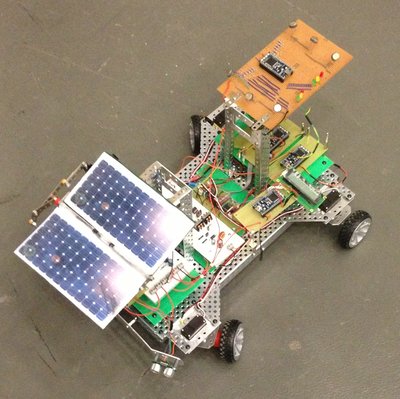Embedded Four(4) Networked-mbed Processors Autonomous Guided Vehicle (AGV) Using Controller Area Net

The AGV is an autonomous robot with four (4) Mbed NXP LPC1768 processors that provide the required intelligence and device drivers required for interfacing the temperature and humidity sensors, proximity sensors and a camera networked using Controller Area Network (CAN) protocol. It is a multiple mobile robot because it can perform distributed task (sensing and action), move freely and could be completely autonomous. It also has the ability to navigate, predict and avoid collision, perform fixed or dynamic goals while exploring or covering an area of concern. The AGV is applicable in environmental data acquisition, environment monitoring and exploration, geographical mapping, research and inspection work of hazardous areas. The unmanned vehicle which is based on an embedded platform was proposed in an effort toward the development of a wireless environmental data logging system and an explorer in hazardous area.
Design Specification Each networked Mbed processor unit is a sub-system called the Electronic Control Unit (ECU). There are four ECUs namely; 1. Drive Electronic Control Unit (DECU) 2. Collision Avoidance Electronic Control Unit (CaECU) 3. Climate Surveillance Electronic Control Unit (CSECU) 4. Diagnostics and Communication Electronic Control Unit (DCECU) 5. Tilt Monitoring Electronic Control Unit (TECU)
In addition, the Motion Management Controller (MMC) subsystem will allow the AGV to be remotely controlled from the PC by sending control commands to activate or deactivate the AGV. It comprises of control relays and microcontrollers.
/* DRIVE SUSBSYSTEM
- ******************
- Filename
- "/DRIVE ECU/main.cpp" *
- https
- mbed.org/compiler/ *
- *
- Networked Processors Autonomous Guided Vehicle (AGV) *
- *
- Presented by
- *
- Aniebiet Micheal Ezekiel
- include "mbed.h"
CAN can1(p30, p29); Configure a serial port, pins 30 and 29 as rd and td respectively Serial pc(USBTX, USBRX);
PwmOut PWM1(p21); Forward Left DC Motors PwmOut PWM2(p22); Backward Left DC Motors PwmOut ServoB(p23); Frontleft servo PwmOut ServoF(p24); BackRight servo PwmOut PWM3(p25); Forward Right DC Motors PwmOut PWM4(p26); Backward Right DC Motors
DigitalOut myled1(LED1); DigitalOut myled2(LED2); DigitalOut myled3(LED3); DigitalOut myled4(LED4);
CANMessage msg;
Ticker timeupps; define Ticker for light Ticker timeuppps; define Ticker for obstacles
CAN SEND ID
0x0a: drive send to Diagnostics 0x0b: drive send to Camera 0x0c: obstacles send to Drive 0x0d: diagnostics send to Camera 0x0e: camera send to Diagnostics 0x0f: temprature/humidity send Climatic condition to diagnostics 0x1f: temprature/humidity send Temperature value to diagnostics 0x2f: temprature/humidity send Humidity value to diagnostics
CAN messages char diag_msg1 = 1; AGV moves front message: AGV explores: No obstacles message char diag_msg2 = 2; AGV moves fast front message char diag_msg3 = 3; AGV turns right message char diag_msg4 = 4; AGV turns left message char diag_msg5 = 5; AGV starts message char diag_msg6 = 6; AGV stops message char diag_msg7 = 7; AGV Increases speed; temperature adverse char diag_msg8 = 8; AGV normal speed; temperature normal
call functions void TempS(void); Temperature call function void ObstS(void); Obstacle call function
Drive functions void front(void); void fast_front(void); void back(void); void front_left(void); void left(void); void front_right(void); void right(void); void stop(void);
int main() { CANMessage msg; printf("read...\n"); printf("send...\n");
if(can1.write(CANMessage(0x0a, &diag_msg5,1))) { pc.printf("Message sent: %d\n", diag_msg5); myled3=!myled3; }
timeupps.attach(&ObstS, 0.02);
PWM1.period(0.010); set PWM period to 10 ms (motor) PWM2.period(0.010); set PWM period to 10 ms(motor) PWM3.period(0.010); set PWM period to 10 ms(motor) PWM4.period(0.010); set PWM period to 10 ms(motor) ServoF.period_ms(20); set PWM1 period to 20 ms(servo) ServoB.period_ms(20); set PWM2 period to 20 ms(servo)
ServoF.pulsewidth_us(1400); update PWM pulse with to 90* ServoB.pulsewidth_us(1400); update PWM pulse with to 90*
while(1) { } }
Obstcales function starts void ObstS() { if(can1.read(msg)) { pc.printf(" - Message received: %d\n", msg.data[0]); pc.printf("\n Message id :%d", msg.id); if (msg.id==0x0c) { myled1=!myled1; if (msg.data[0]==1) { stop(); AGV stops to take Picture wait (5); front_right(); obstacles left; AGV moves right if (msg.data[0]==2) { stop(); AGV stops to take Picture wait (5); front_right(); obstacles centre; AGV moves right } } if (msg.data[0]==3) { stop(); AGV stops to take Picture wait (5); front_left(); obstacles right; AGV moves left } if (msg.data[0]==4) { ServoF.pulsewidth_us(1400); PWM1=0.75; PWM2=0; PWM3=0.75; PWM4=0;
if(can1.write(CANMessage(0x0a, &diag_msg1,1))) { pc.printf("Message sent: %d\n", diag_msg1); myled3=!myled3; } front(); no obstacles; AGV move straight and seeks for enviromental condition timeuppps.attach(TempS, 1); } else { myled1=0; } wait(0.1); delete if possible } } } Obstacle Function ends
Temperature Function Starts void TempS () { if(can1.read(msg)) { fast_front(); Adverse environmental condition optional send below; may delete if(can1.write(CANMessage(0x0a, &diag_msg7,1))) { pc.printf("Message sent: %d\n", diag_msg7); myled3=!myled3; pc.printf(" - Message received: %d\n", msg.data[0]); pc.printf("\n Message id :%d", msg.id); if (msg.id==0x0f) { myled2=!myled2; if (msg.data[0]==4) {
} }
if (msg.data[0]==3) { front(); Normal operation, favourable condition optional send below; may delete if(can1.write(CANMessage(0x0a, &diag_msg8,1))) { pc.printf("Message sent: %d\n", diag_msg8); myled3=!myled3; } } else { myled2=0; } wait(0.1); delete if possible } } } Temperature Function ends
Maneuvering Codes Begin void front() { ServoF.pulsewidth_us(1400); PWM1=0.75; PWM2=0; PWM3=0.75; PWM4=0;
if(can1.write(CANMessage(0x0a, &diag_msg1,1))) { pc.printf("Message sent: %d\n", diag_msg1); myled3=!myled3; } }
void fast_front() { ServoF.pulsewidth_us(1400); PWM1=1; PWM2=0; PWM3=1; PWM4=0;
if(can1.write(CANMessage(0x0a, &diag_msg2,1))) { pc.printf("Message sent: %d\n", diag_msg2); myled3=!myled3; } }
void back() { ServoF.pulsewidth_us(1400); PWM1=0; PWM2=0.75; PWM3=0; PWM4=1; }
void front_right() { ServoF.pulsewidth_us(1650); PWM1=0.75; PWM2=0; PWM3=1; PWM4=0; if(can1.write(CANMessage(0x0a, &diag_msg3,1))) { pc.printf("Message sent: %d\n", diag_msg3); myled3=!myled3; } }
void right() { ServoF.pulsewidth_us(1900); PWM1=0.75; PWM2=0; PWM3=0.75; PWM4=0;
if(can1.write(CANMessage(0x0a, &diag_msg3,1))) { pc.printf("Message sent: %d\n", diag_msg3); myled3=!myled3; } }
void front_left() { ServoF.pulsewidth_us(1150); PWM1=0.75; PWM2=0; PWM3=0.5; PWM4=0; if(can1.write(CANMessage(0x0a, &diag_msg4,1))) { pc.printf("Message sent: %d\n", diag_msg4); myled3=!myled3; } }
void left() { ServoF.pulsewidth_us(900); PWM1=0.75; PWM2=0; PWM3=0.5; PWM4=0;
if(can1.write(CANMessage(0x0a, &diag_msg4,1))) { pc.printf("Message sent: %d\n", diag_msg4); myled3=!myled3; } }
void stop() { ServoF.pulsewidth_us(1400); PWM1=0; PWM2=0; PWM3=0; PWM4=0;
if(can1.write(CANMessage(0x0a, &diag_msg6,1))) { pc.printf("Message sent: %d\n", diag_msg6); myled3=!myled3; } } Maneuvering codes end.
Please log in to post comments.
